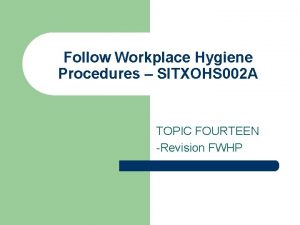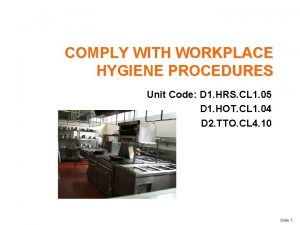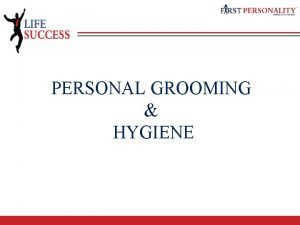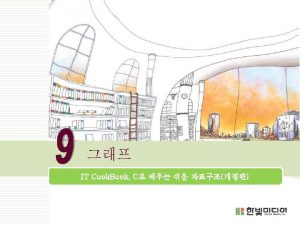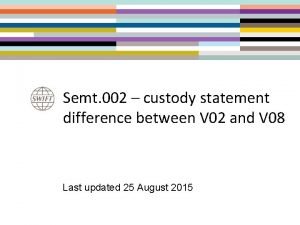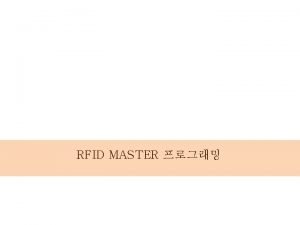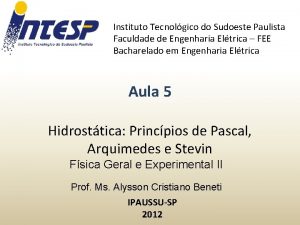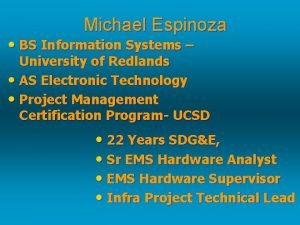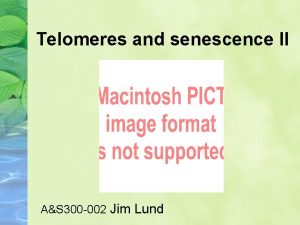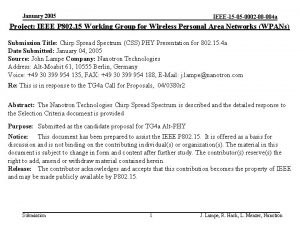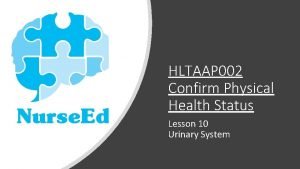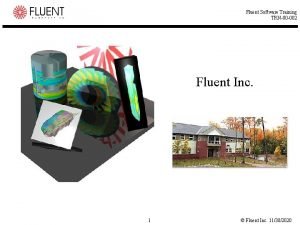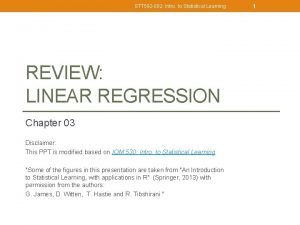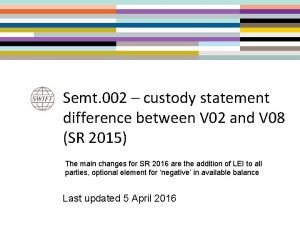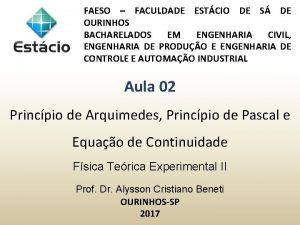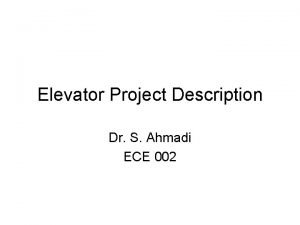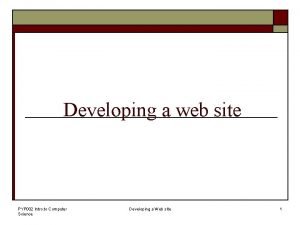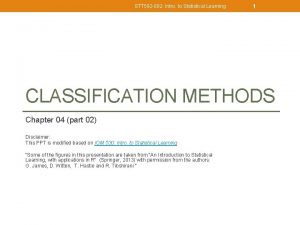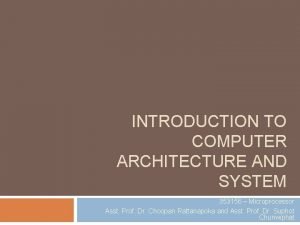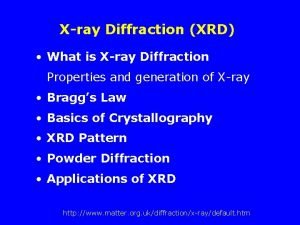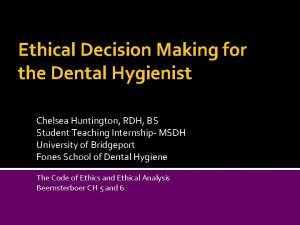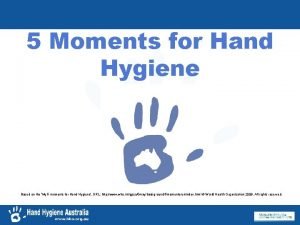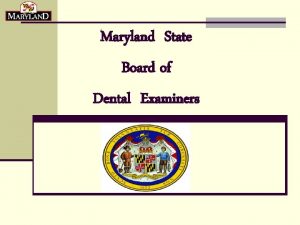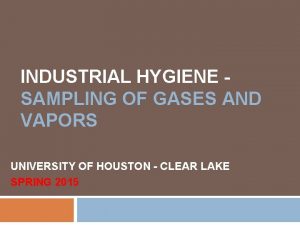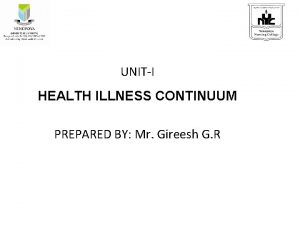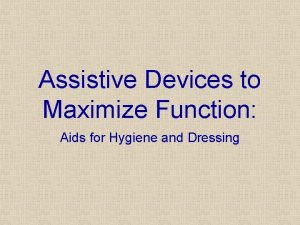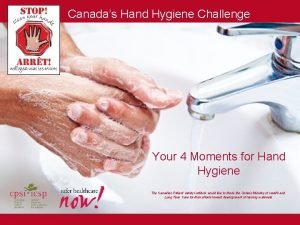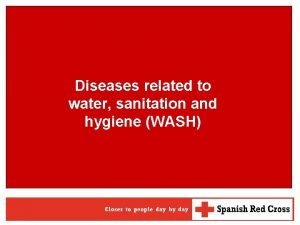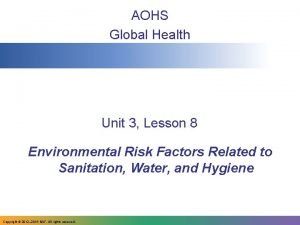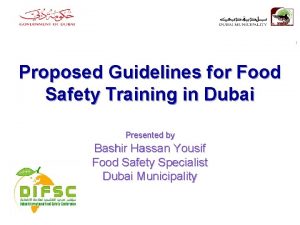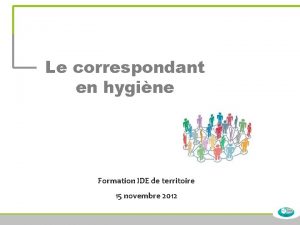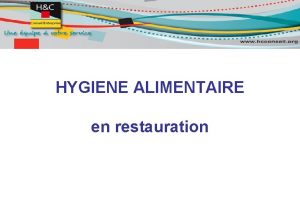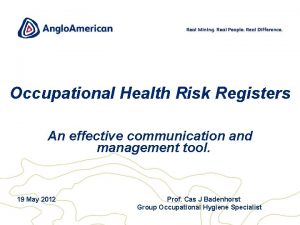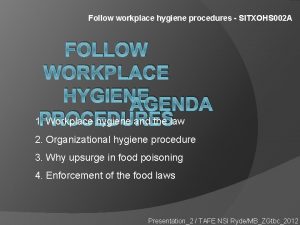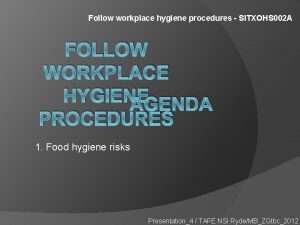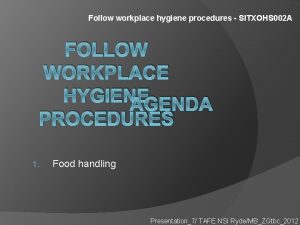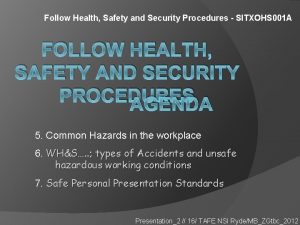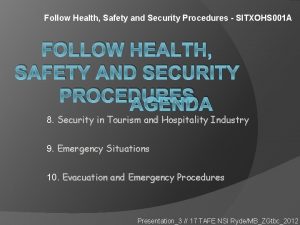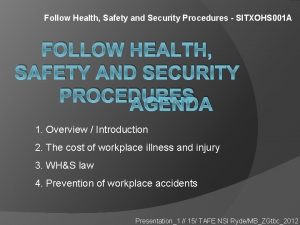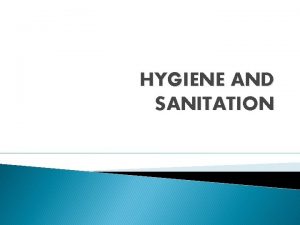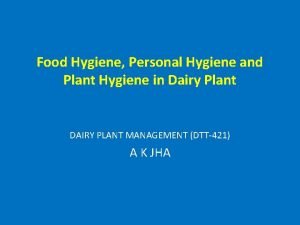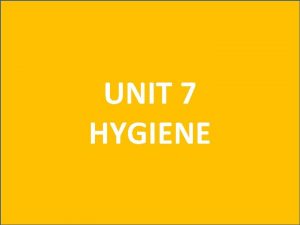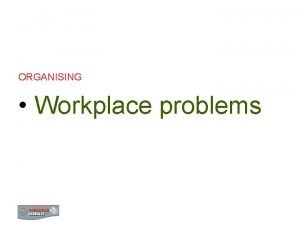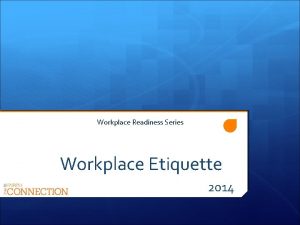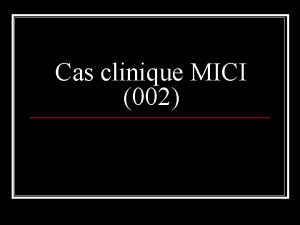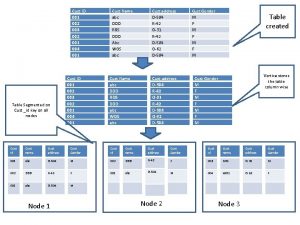Follow Workplace Hygiene Procedures SITXOHS 002 A TOPIC














































- Slides: 46

Follow Workplace Hygiene Procedures – SITXOHS 002 A TOPIC FOURTEEN -Revision FWHP

On completion of this session you will be able to: l l l Explain the legal and moral obligations or individuals and organisations to maintain good hygiene. Distinguish between environmental, personal and food hygiene. State a range of control procedures including cleaning, sanitising, garbage disposal and pest control. State the requirements of individuals to maintain good hygiene. Distinguish between microbial, chemical and physical contamination. Explain how bacteria spread and multiply.

On completion of this session you will be able to: l l l Explain the differences between food poisoning, foodborne illness and food spoilage. Identify varieties of food poisoning and their main source. State the appropriate storage of food items that meets legal requirements. Explain how we control the dangers associated with poor food hygiene. Describe the potential consequences of disregarding hygiene procedures.

Legal Requirements l l l NSW OHS Act 2000 / Regulation 2001 NSW Food Act 2003 / Regulation 2010 FSANZ Food Safety Standards (ANZFA) Food Premises Code Building Code of Australia

Food standards Australia New Zealand (ANZFA) l Joint statutory body that develops food standards for composition, labelling and contaminants that cover the whole food chain whether produced, or imported for sale, in Australia.

What is a FSP? l l Food Safety Program This program assists (food) businesses in identifying any hazards in the food operation that may cause harm to consumers, and the steps to be taken to control the hazard.

What is HACCP l l Hazard Analysis Critical Control Points Internationally accepted prevention and riskbased food safety system.

Business Owner’s responsibility for good hygiene l l Ensure premises conform to all relevant (design) legislation Maintain adequate and appropriate food storage areas Install separate hand washing and food cleaning basins Observe and enforce hygienic food handling practices

Business Owner’s responsibility for good hygiene l l l Maintain appropriate cleaning and sanitising procedures Train employees in personal hygiene and correct food handling Install employee wash rooms

Employees responsibility for good hygiene l l l Maintain high standard of personal hygiene Follow food handling procedures/practices Understand the nature of foods and their susceptibility to bacteria growth Minimise food wastage Maximise food shelf life Report food hygiene breaches

Employees responsibility for good hygiene l l l Report communicable diseases (don’t work when carrying or infected) Observe correct cleaning and sanitising Wear appropriate protective clothing Follow procedures for handling blood spills, the disposal of sharps and dirty linen Cover skin lesions

Environmental hygiene l l Those activities undertaken for maintaining clean and hygienic premises. The ‘environment’ refers to – – Employee-only areas (wash rooms, cafeteria) Food preparation areas (kitchens) Food storage areas Public areas (public toilets, bars, restaurants, guestrooms, foyers)

What is ‘cleaning’? l l Cleaning is the removal of any dirt, scum or food scraps usually by washing in hot water using a detergent. Cleaning does not mean an item/surface is fee of bacteria.

What are ‘detergents’? l Detergents are cleaning agents that help breakdown oils and fat and remove food scraps and dirt from surfaces, utensils and equipment.

What is ‘sanitising’? l l Sanitising is the elimination or reduction of potentially harmful bacteria to a safe level, through the application of heat or using a (sanitising) chemical. Sanitising takes place after an item/surface has been cleaned.

What is ‘sanitising’? l l All food preparation surfaces and work areas, and food service equipment and utensils are sanitised using either hot water or appropriate, food safe, sanitising chemical. Public toilets, guestroom bathrooms and hard floor surfaces are sanitised using a commercial grade disinfectant.

Garbage disposal l l Is the removal of all waste products (food items, scraps, general rubbish) from the premises. Inappropriate handling and storage of garbage can attract pests and cause disease. Always wear gloves when disposing of garbage. Always wash hands after handling garbage.

Garbage disposal l To maintain appropriate environmental hygiene while disposing of garbage: – – Place all garbage designated bin lined with a disposable garbage bag. Use bins with tight fitting lids. Keep lids on while bins not in use. Remove storage form work areas frequently (to outside storage facility). Clean and sanitise bins frequently (eg. Daily, weekly).

Pest control l l Pest control is the elimination of actual pests or the implementation of systems and procedures that reduces the likelihood of infestation. Control measures must include: – – – Restriction of access Detection and identification Destruction and elimination

Pests in hospitality enterprises l l l Rodents – mainly food areas, storage areas, garbage disposal areas Flies – everywhere, particularly food areas Cockroaches – food and beverage areas, storage areas, garbage disposal areas Moths – food and linen storage areas, guestrooms Silverfish – guestrooms, linen storage areas Ants – anywhere there is or was food

Personal hygiene l The individual’s hygiene – bathing, oral hygiene, hand washing, shampooing, skin care, body odour, foot care.

Personal hygiene l l l Hospitality employees are expected to observe a high standard of personal hygiene. Not only is this a requirement of the workplace but enforceable under the food premises code and other regulations. Failure to observe good personal hygiene can lead to food contamination and possibly dismissal.

Personal hygiene in the kitchen l l l Separate cooked and raw foods Clean work areas as you go Do not smoke or spit Do not touch any part of your body Wash hands before each new task Wear disposable gloves when handling food

Personal hygiene when cleaning l l l Wear disposable gloves Wash hands after each cleaning task Do not smoke or spit Do not handle food during cleaning Using the right chemical on the right surface

Food hygiene l l l The destruction of all and any bacteria that are harmful in food, through cooking or other processes Protection of food from contamination Correct food handling procedures.

Poor food hygiene l Failure to observe correct food hygiene can lead to contamination: – – Bacterial contamination Cross contamination Chemical contamination Physical contamination

Microbial contamination l l Occurs when otherwise healthy food comes into contact with pathogenic bacteria (dangerous bacteria that can poison food and harm people). Also referred to as cross contamination.

Cross contamination l Occurs when bacteria are transferred to healthy food through contact with a contaminated surface, contaminated food or from the food handler.

Chemical contamination l Occurs when otherwise healthy food is contaminated through exposure to chemicals (such as cleaning a food preparation surface with a disinfectant instead of a sanitiser).

Physical contamination l Occurs when foreign objects fall or are mixed into food during cooking or handling. Examples include: – – – Insects Hair Finger nails Band aids Plastic/glass

What are ‘bacteria’? l l l Living, single-cell micro-organisms. Harmful bacteria are called ‘pathogens’ Bacteria exist everywhere and are easily transferred to food, surfaces, other people.

How bacteria grow l l Bacteria multiply through a process of binary fission. Each individual cell, in the right conditions, separates into two, every twenty minutes. These two cells then separate into two more cells More than one million bacteria fits onto a pin head.

The right conditions for bacteria to grow (FAT TOM) l l l Food (almost anything), rich in protein Water (even minimal moisture content) Temperature (prefers between 5ºC & 60ºC. Kitchens, public toilets and guest rooms are always within this range) Time Oxygen (but some grow without oxygen) PH level Acid/alkaline (prefer foods low in acid)

What is a ‘food-borne illness’? l An illness arising from the consumption of a food that is naturally poisonous, contaminated by chemicals or from poor storage, such as blown cans, mouldy peanuts.

What is ‘food spoilage’? l l l Food spoilage is the reduction in quality or deterioration of food through poor handling storage or age. Spoilage bacteria (eg. Mould on fruit) is not pathogenic and therefore unlikely to cause illness. Food spoilage can be avoided through correct storage and handling

Useful bacteria l Useful bacteria is used in many food processing applications and includes: – – Some moulds in some cheeses, yoghurt, and dessert wine Yeasts in beer, champagne and bread production

What is ‘food poisoning’? l Food poisoning is the illness that occurs from consuming contaminated food or water (food or water contaminated with pathogenic bacteria).

How do you destroy bacteria? l l Heat – the higher the temperature, the quicker the destruction. If the food cannot be heated to the required temperature (usually over 65ºC), dispose of it.

What is the ‘temperature danger zone’? l l This is the temperature range within which bacteria grow best. Bacteria grow best between 5ºC and 60ºC

Controlling the dangers l l l l Minimise exposure of foods in the danger zone Keep hot food hot and cold food cold Cool cooked foods rapidly, in small quantities Cook processed foods thoroughly Thaw foods in the fridge Don’t refreeze thawed food Reheat left-overs to a high temperature

Controlling the dangers l l l Store cooked and raw foods separately Wash fruit and vegetables thoroughly Rotate stock properly Clean as you go Use a clean chopping board and clean knife when changing from preparing raw foods to cooked foods Was hands regularly

Storage conditions l l l Food products are stored according to their nature. To maximise shelf life, store foods correctly Clean storage areas regularly

Dry stores l l Store items off the ground Store items in sealable containers Maintain temperature between 10ºC and 15ºC Types of foods include: – – – Flour Sugar Sweet and dry biscuits Canned foods Rice and pasta Cereals

Refrigeration l l l Used to store perishable and semi-perishable products Keep temperature between 1ºC and 3ºC Store raw foods below cooked Keep food types separated Types of foods include: – – Meat Fish and seafood Fruits and vegetables Dairy products

Freezer storage l l Frozen foods should be stored at -18ºC or colder Not all food types can be frozen Once thawed, do not refreeze Types of foods – – Meat (raw and some cooked – depending on ingredients) Ice-cream Some vegetables Some fruits

Consequences of disregarding hygiene procedures l l l Unnecessary food costs Contaminated food Complaints from customers Outbreak of food poisoning Closure of enterprise Loss of jobs
 Follow workplace hygiene procedures
Follow workplace hygiene procedures Follow workplace hygiene procedures
Follow workplace hygiene procedures Chapter 10 workplace safety procedures
Chapter 10 workplace safety procedures I will follow you wherever you will go
I will follow you wherever you will go Personal grooming importance
Personal grooming importance General subject example
General subject example Research problem example for students
Research problem example for students 001 002 003
001 002 003 Semt.002
Semt.002 C++ mfc 예제
C++ mfc 예제 Pressão hidrostática
Pressão hidrostática Cip 002-009
Cip 002-009 002
002 Cutting speed for cast iron
Cutting speed for cast iron 0,05/0,002
0,05/0,002 002
002 Norsok z-018
Norsok z-018 002
002 Gmas-002
Gmas-002 002
002 002
002 Semt.002
Semt.002 001 002 003
001 002 003 Um objeto com massa de 10kg e volume de 0 002
Um objeto com massa de 10kg e volume de 0 002 002
002 Site structure
Site structure 002
002 002
002 Puneeth iyengar
Puneeth iyengar Dtu p 06-002
Dtu p 06-002 Um objeto com massa de 10kg e volume de 0 002
Um objeto com massa de 10kg e volume de 0 002 002
002 Ethical dilemma examples in dental hygiene
Ethical dilemma examples in dental hygiene Moment 3 hand hygiene
Moment 3 hand hygiene Maryland state board dental examiners
Maryland state board dental examiners Male function
Male function Wolf
Wolf Define health illness continuum
Define health illness continuum Personal hygiene assistive devices
Personal hygiene assistive devices 4 moments of hand hygiene canada
4 moments of hand hygiene canada Sanitation and hygiene
Sanitation and hygiene Précautions standard hygiène
Précautions standard hygiène Unit 3 health and hygiene
Unit 3 health and hygiene Food hygiene training in dubai
Food hygiene training in dubai Correspondant en hygiène
Correspondant en hygiène Arbre de decision haccp
Arbre de decision haccp Occupational hygiene programme template
Occupational hygiene programme template
